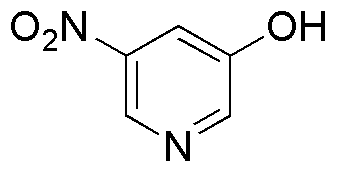3-Hydroxy-4-nitropyridine is widely utilized in research focused on:
- Pharmaceutical Development: This compound serves as an important intermediate in the synthesis of various pharmaceuticals, particularly those targeting neurological disorders. Its unique structure allows for modifications that enhance drug efficacy.
- Agricultural Chemicals: It is used in the formulation of agrochemicals, including herbicides and fungicides. The compound's ability to inhibit specific enzymes makes it valuable for developing effective crop protection agents.
- Analytical Chemistry: 3-Hydroxy-4-nitropyridine is employed as a reagent in analytical methods, such as spectrophotometry. Its distinct absorbance properties facilitate the detection and quantification of other compounds in complex mixtures.
- Material Science: This chemical is explored in the development of new materials, particularly in the field of polymers. Its incorporation can enhance the thermal stability and mechanical properties of polymeric materials.
- Environmental Monitoring: It is used in the detection of pollutants in environmental samples. The compound can be part of sensor technologies that monitor water quality, providing a means to ensure safe drinking water.
General Information
Properties
Safety and Regulations
Applications
3-Hydroxy-4-nitropyridine is widely utilized in research focused on:
- Pharmaceutical Development: This compound serves as an important intermediate in the synthesis of various pharmaceuticals, particularly those targeting neurological disorders. Its unique structure allows for modifications that enhance drug efficacy.
- Agricultural Chemicals: It is used in the formulation of agrochemicals, including herbicides and fungicides. The compound's ability to inhibit specific enzymes makes it valuable for developing effective crop protection agents.
- Analytical Chemistry: 3-Hydroxy-4-nitropyridine is employed as a reagent in analytical methods, such as spectrophotometry. Its distinct absorbance properties facilitate the detection and quantification of other compounds in complex mixtures.
- Material Science: This chemical is explored in the development of new materials, particularly in the field of polymers. Its incorporation can enhance the thermal stability and mechanical properties of polymeric materials.
- Environmental Monitoring: It is used in the detection of pollutants in environmental samples. The compound can be part of sensor technologies that monitor water quality, providing a means to ensure safe drinking water.
Documents
Safety Data Sheets (SDS)
The SDS provides comprehensive safety information on handling, storage, and disposal of the product.
Product Specification (PS)
The PS provides a comprehensive breakdown of the product’s properties, including chemical composition, physical state, purity, and storage requirements. It also details acceptable quality ranges and the product's intended applications.
Certificates of Analysis (COA)
Search for Certificates of Analysis (COA) by entering the products Lot Number. Lot and Batch Numbers can be found on a product’s label following the words ‘Lot’ or ‘Batch’.
*Catalog Number
*Lot Number
Certificates Of Origin (COO)
This COO confirms the country where the product was manufactured, and also details the materials and components used in it and whether it is derived from natural, synthetic, or other specific sources. This certificate may be required for customs, trade, and regulatory compliance.
*Catalog Number
*Lot Number
Safety Data Sheets (SDS)
The SDS provides comprehensive safety information on handling, storage, and disposal of the product.
DownloadProduct Specification (PS)
The PS provides a comprehensive breakdown of the product’s properties, including chemical composition, physical state, purity, and storage requirements. It also details acceptable quality ranges and the product's intended applications.
DownloadCertificates of Analysis (COA)
Search for Certificates of Analysis (COA) by entering the products Lot Number. Lot and Batch Numbers can be found on a product’s label following the words ‘Lot’ or ‘Batch’.
*Catalog Number
*Lot Number
Certificates Of Origin (COO)
This COO confirms the country where the product was manufactured, and also details the materials and components used in it and whether it is derived from natural, synthetic, or other specific sources. This certificate may be required for customs, trade, and regulatory compliance.


